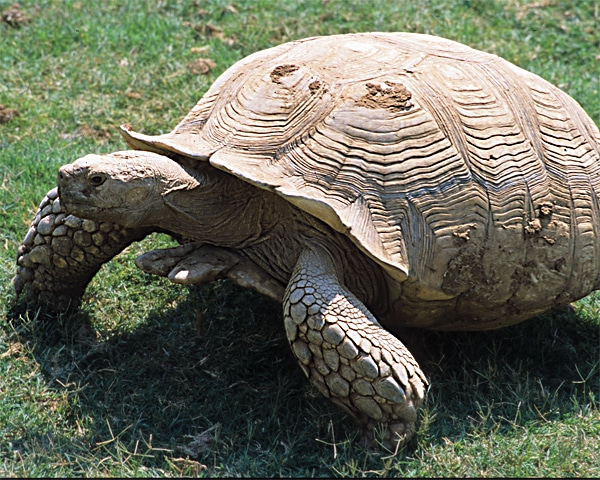One of the most popular tortoises in the pet trade is the African spurred tortoise (Geochelone sulcata), because of its outgoing and animated personal
One of the most popular tortoises in the pet trade is the African spurred tortoise (Geochelone sulcata), because of its outgoing and animated personality along with its availability and hardiness in captivity. Due to the similarity of their common names and enlarged scales on their front legs, G. sulcata is occasionally confused with the spur-thighed tortoise (Testudo graeca), leading many people to now refer to G. sulcata by an alternative common name: the sulcata tortoise. The “spurred”part of its name is derived from the large, pointed scales on the tortoise’s forelimbs.
Read More
Sulcata Tortoise Health Problems
Sulcatas are XXXL
Geochelone sulcata gets big—individuals can reach more than 200 pounds in weight and 36 inches in length. Its shape is round, with a tan-colored, patternless shell that is more flat than domed. The word “sulcata” comes from the Latin word sulcus, meaning a groove or furrow. In regard to the sulcata tortoise, this refers to the distinctive growth rings that are produced as the tortoise’s scutes grow with each seasonal cycle. New shell growth that appears around each scute begins as dark brown in coloration, but usually fades to a straw color as it is bleached by the sun over the years as the tortoise matures.
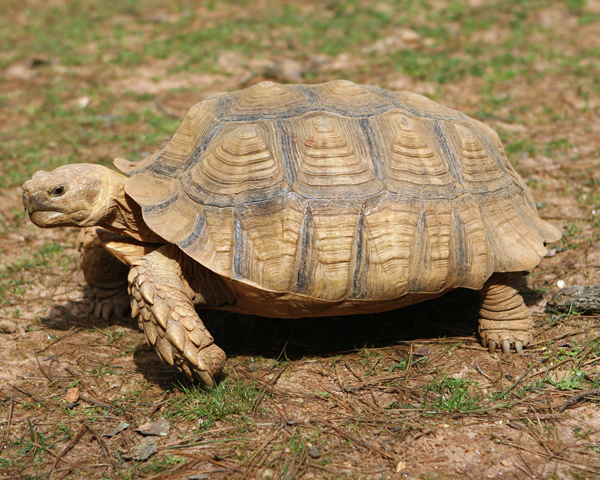
E. J. Pirog
The common name of African “spurred” tortoise is due to the enlarged, pointed scales on the forelimbs of Geochelone sulcata.
There is a noticeable difference between male and female sulcatas, but it does not become evident until they are at least 10 to 15 pounds or larger. Males develop a concave plastron with anal scutes that form a “V” where the tail protrudes. As with most chelonians, the male’s tail will also be much longer than the female’s—sometimes long enough to wrap around to the back of the tortoise’s thigh.
A female is usually not as round in appearance when compared to a male. The plastron of a female is also flat, with anal scutes that form more of a “U” shape where the tail protrudes to allow the passing of eggs. A female’s tail is much shorter than a male’s, and all these sexual characteristics become more pronounced as the tortoises get bigger in size.
Where Wild Sulcatas Roam
The home range of G. sulcata is an approximately 250-mile-wide strip of land that straddles the 15-degree north latitude, which is a line from Senegal to the small country Eritrea, just north of Ethiopia. This relatively narrow strip of territory traverses the North African continent roughly corresponding with the transition zone between the Sahara Desert and the savannah/forest area known as the Sudan region that lies south of the Sahara. This transition zone is called the Sahel, and it is a very unique biozone that features short shrubs, grasses and dwarfed trees. It is not quite desert and not quite savannah.
Because of its location, the Sahel can be a desert environment during some years, and savannah during others, depending on the prevailing weather patterns. During any given year, it can receive 5 to 20 inches of rain, usually during the monsoon season that typically lasts from July to November.
The Sahel is not only a transitional zone for the weather between the desert and the Sudan region, it is one in regard to soil fertility, as well. The soil of the Sahel is only slightly more fertile than the desert, but less so than the Sudan region. This is important, because even during times of plentiful rain, the vegetation of the Sahel remains stunted because of the soil’s low fertility.
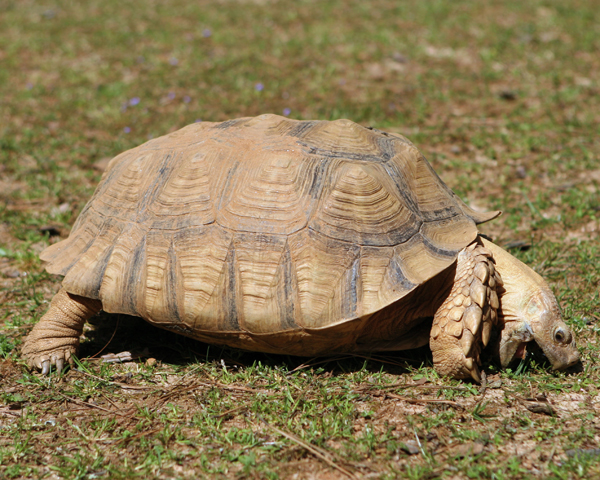
E. J. PIROG
Sulcatas spend a lot of their time grazing, and appropriate grasses should be planted in their outdoor enclosures.
Sulcata tortoises dig extensive burrows during the monsoon season, in preparation for when they will need to seek refuge from the extreme heat of the dry season, as well as escape from the high midday temperatures that occur during the rest of the year. Sulcata burrows can extend horizontally well over 30 feet, with a vertical depth of more than 20 feet in many cases. The depth of a burrow provides a safe environment with relatively stable temperatures for a tortoise, despite the huge temperature fluctuations that occur outside of the burrow. The depth of the burrow also provides humidity levels that are commonly over 50 percent.
Sulcata burrows usually include multiple chambers and connecting tunnels, and other animals may seek refuge in them along with the tortoises—animals that may serve as a food source for hungry sulcatas during lean times. Like most tortoises, sulcatas are opportunistic feeders in the wild. They feed mostly on the abundant growth that follows the rainy season, consuming grasses, broad leaf weeds, leaves and fruit from trees and bushes.
After the wet season, they will feed on almost any organic matter they can find, including dried plants and leaves that remain during the dry season. During times of little to no plant growth, sulcatas have been known to also consume small branches, tree bark, animal feces and carrion.
During the height of the dry season, sulcatas remain mostly inactive, and they are seldom, if ever, seen outside their burrows. When the rainy season arrives they will emerge to forage and replace lost reserves for reproduction. Breeding and egg laying usually takes place at this time, although there is not an exclusive breeding season. Low population densities of male sulcatas result in breeding throughout the year, whenever a male encounters a female (which is not very often). Such encounters occur most frequently during the beginning of the rainy season and toward the end, when sulcata tortoises are the most active. It has been reported that nesting in the wild often occurs at the base of bushes, where a female tortoise may lay as many as 24 eggs, though fewer are usually deposited. This typically occurs from November to May.
There is a distinct correlation between the number of sulcata eggs deposited and the size of the eggs. As a rule, smaller clutch sizes generally result in larger eggs, while larger clutch sizes result in smaller eggs. Depending on the time of year they were deposited, sulcata eggs commonly take 100 to 200 days for the hatchlings to emerge. Baby sulcatas are fairly large and quick when they leave the nest. The growth rate for the first two years can be relatively rapid, depending on the time year the hatchlings leave the nest, as well as available resources. Young sulcata tortoises can attain weights slightly in excess of 2 pounds after the first year, and nearly 7 pounds after their second year.
Housing and Care
Keeping a pet sulcata tortoise is straightforward, but there are some crucial considerations, the main one being this tortoise’s large size, mentioned earlier, along with the fact that sulcatas are very active. It can take a sulcata more than 20 years to reach its full size, but with good care it can attain it much sooner, and coupled with its activity level, a large sulcata can quickly become a big problem if its keeper is not prepared. There are many tortoise rescues that are overwhelmed with large sulcatas that previous owners could not care for because they did realize how much time and money is involved in maintaining a full-grown sulcata.
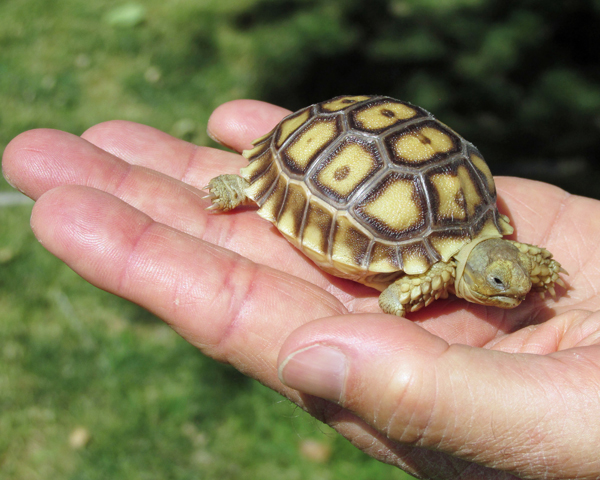
E.J. Pirog
Hatchling sulcata tortoises can be kept in 20-gallon aquariums for a few years, but they will need to be moved to larger quarters—much larger quarters—eventually. Remember this prior to purchasing one.
A hatchling sulcata—one of those cute ones so often seen for sale at reptile shows—can be kept in a standard 20-gallon terrarium only for the first couple years of its life. It’s easy to maintain a proper temperature range of 80 to 95 degrees Fahrenheit in such an enclosure, and adding a humid hide should ensure good tortoise development when coupled with good nutrition. To provide a humid hide, you first have to create a temperature gradient by concentrating the heat at one end of the enclosure, whether provided by heat tape, lights or other heating elements. The temperature at the hot end should be 95 degrees, tapering off to cooler temperatures toward the other end of the enclosure.
The humid hide can be in the form of a container large enough to easily accommodate the tortoise, with an entry hole cut into it and positioned upside down over some slightly moistened sphagnum moss or coconut coir in one of the hotter areas of the enclosure. Providing this is especially important for the first few years of sulcata growth.
Substrates that can be used in the enclosure include soil, a sand/soil mix, pine bark mulch and wood shavings such as aspen bedding or fine aspen chips. Strive to use a substrate comprised of smaller particles, so if any is accidentally ingested by the tortoise, it can be easily passed. Otherwise, you will be risking ingestion/impaction problems for your young sulcata.
As your sulcata hatchling grows larger it is going to need to be moved to larger facilities. After the standard terrarium mentioned previously, the next step may be anything from a larger terrarium to what is commonly called a “tortoise table,” which is basically a large box with sides that are tall enough to prevent the tortoise from climbing over them (read about how to build one here: reptilesmagazine.com/table).
Eventually, though, as a pet sulcata tortoise gets bigger still, it is going to need a room of its own if kept indoors, or an outdoor pen. For this reason, many people start out with their sulcatas outside, even when they’re still young. The outdoor enclosure needs to be secure, with the walls of the enclosure buried a minimum of 6 inches into the ground for smaller tortoises and deeper for larger tortoises. As mentioned, sulcatas are enthusiastic diggers that can easily burrow beneath the walls if they are not sufficiently sunk into the ground. They also have the power to push through a fence that is not secured at both the bottom and the sides, so construct accordingly.
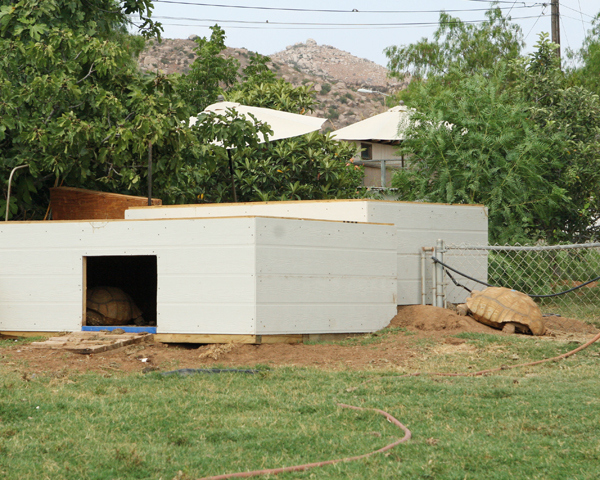
E.J. PIROG
Outdoor pens complete with tortoise houses for shelter are the best way by far to keep adult sulcata tortoises. Keeping them indoors is seldom practical.
Providing a shelter for an outdoor tortoise will often reduce its attempts to burrow out of the enclosure. For smaller sulcatas, a shelter can be a flower pot placed on its side and buried halfway into the ground. It can also be a section of PVC pipe either cut in half lengthwise or buried halfway into the ground lengthwise.
Another option is to build a tortoise house. This is an excellent choice because heating can be easily added. With a heated tortoise house, the tortoise should be able to remain outdoors for many months of the year in most areas. Heating can be provided by using heat mats, heat tubes, ceramic emitters or combinations of heating elements and lights.
Care should be taken when using heat mats; these are designed to be used in open areas, and if the heat they emanate becomes trapped there is potential for a fire hazard. A heat mat should be secured to a wall, or a space should be provided under the enclosure. A rheostat should be used in all cases. I believe that the best heat source is a ceramic heating element used in conjunction with a rheostat, because these are relatively safe (be sure your tortoise can’t come into direct contact with them) and easily controlled.
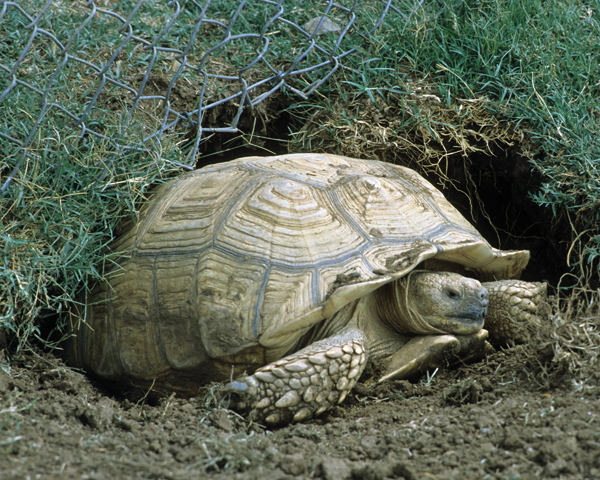
E.J. Pirog
In the wild, sulcata tortoises dig holes during the monsoon season to prepare for the hot, dry season, when they will retreat to their burrows to avoid the extreme heat of their native habitat.
Hydration is crucial. Until they’re about 2 years old, sulcatas are highly susceptible to renal failure. To ensure that they are well hydrated and do not lose too much moisture through respiration, provide a constant source of water and soak the tortoise in a shallow bath three times a week until you know it is using the water dish. A humid hide as previously described should also be provided; outdoor hides will depend on where you live. In humid regions, maintaining humidity in a hide is not really a problem. In desert climates, the inside of the hide should be moistened every so often.
Sulcatas are found in naturally flat grasslands. When kept outdoors, their pens should be open and planted with grasses such as Bermuda or orchard grass. Some small shrubbery should be spaced about for shade; some good types to include would be hibiscus or waxleaf.
Feeding Sulcatas
If sulcatas have free range of a well-planted lawn, they are content to spend most of the day grazing on the grass. They will eat most grasses and broad-leaf weeds in addition to anything they can catch, including bugs, slugs and snails. If an injured rodent or bird should end up in its yard, it will most likely fall victim to the tortoise.
Provide your sulcata with plenty of dark, leafy greens, such as romaine lettuce, escarole, endive, green-leaf lettuce and kale, and occasional veggies, such as carrots, broccoli, bell peppers and squash, among others. If available, Bermuda and orchard hay are good supplemental items. Fruits such as apples, pears, melons and bananas can be offered in small quantities, as can berries such as strawberries, blackberries, blueberries and others. Collard, mustard and turnip greens can also be offered in limited quantities.
It is very important to provide as much variety as possible. Another option is to supplement with one of the popular pelleted diets available today. Most are formulated by animal nutritionists and are as complete as you can find based on what we know about these tortoises’ nutritional requirements. Some have been researched for many years and have a great record for contributing to the proper development of tortoises. With a varied and balanced diet, vitamin supplements should not be needed with the exception of a light dusting of calcium carbonate added to each feeding.
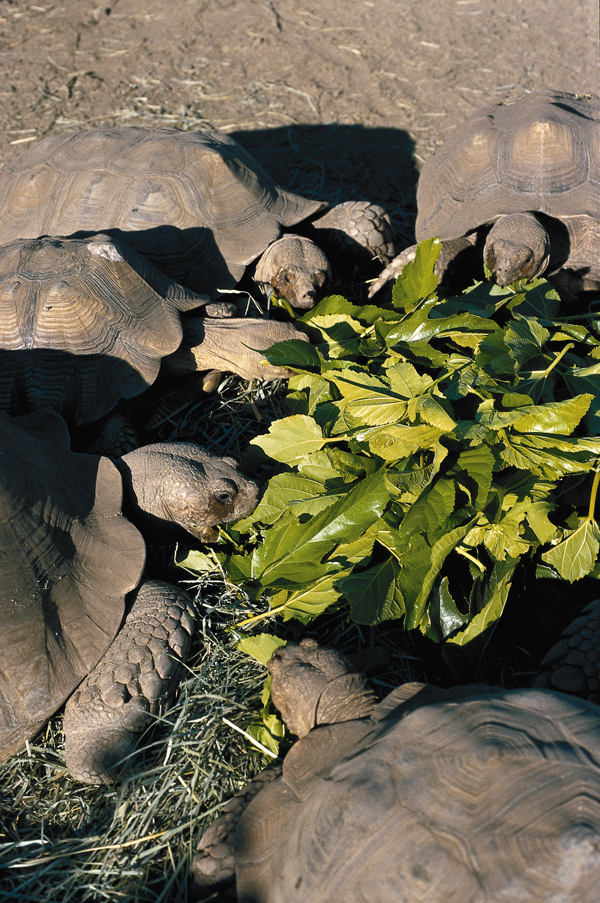
E.J. Pirog
Sulcata are hearty eaters.
The sulcata tortoise makes a fantastic pet for someone with the space to keep such a large tortoise, and who can provide the proper care. This tortoise will delight its keeper with its personality, but if you decide to pick up an inexpensive, cute baby sulcata tortoise at the next reptile show or shop you visit, remember to consider what will later be required to keep it when that baby becomes an adult.
If you are interested in obtaining an adult sulcata, and have the facilities in order to keep one, consider adopting one. Reptile rescues and shelters often have adult sulcatas available. Just make sure you have everything in order and know what you are getting into, because you will likely be asked about how you will take care of the tortoise. That’s a good thing, because remember: responsible tortoise keeping helps keep the hobby thriving.
E.J. Pirog has been keeping keeping chelonians, among other reptiles and amphibians, for more than 40 years. He has written many articles, in addition to some books, about these animals, a passion that he likes to share.

